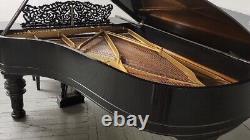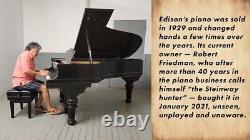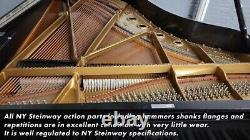
- Grand Piano Model
- Brand
- Instrument
- Length
- Model
- Ddp-100 (11)
- Grand (83)
- Grand Piano (33)
- Kawai Grand (16)
- Mason & Hamlin (22)
- Micropianord (12)
- Model A (25)
- Model B (19)
- Model D (12)
- Model M (18)
- Model O (28)
- Model: (13)
- Pianos (20)
- Quilted (38)
- St-6 (12)
- Steinway Grand Piano (59)
- Steinway Model B (13)
- Steinway Model L (18)
- Steinway Model M (15)
- Upright (166)
- ... (2362)
- Size
- Type
- Baby Grand Piano (104)
- Chair (13)
- Concert Grand Piano (9)
- Digital Piano (21)
- Door Hinge Half (7)
- Figurine (7)
- Grand Model Kit (86)
- Grand Piano (1013)
- Grand Piano Cover (86)
- Grand Piano Covers (66)
- Hinge Half (13)
- Music Ornaments (39)
- Parts (10)
- Piano (5)
- Piano Accordion (16)
- Piano Cover (27)
- Regular Type (6)
- Strobe Tuner (11)
- Upright Model Kit (155)
- Virtual Instrument (6)
- ... (1295)
Thomas Edison's Steinway & Sons Model B 1890














Over 25 Million Views on YouTube: Living Pianos Official YouTube Channel. Edison Steinway: This is the piano that shaped the sound of recorded piano music. Edison bought this piano new from Steinway in June of 1890. It was the piano in his lab which he used to develop his recording technology. Many world-famous musicians visited his lab, including Rachmaninoff. Rachmaninoff saw recording as another source of considerable revenue possibilities. Perhaps because of his reputation as the inventor of recorded sound, Rachmaninof decided to accept Thomas Edison's offer and made his first recordings in April 1919 at the Edison recording studio. Edison was extremely hard of hearing.
When pianists would come to his lab to play his Steinway, he would bite into the wood of the piano in order to transfer sound better so he could hear the playing. Edison's bite marks are evident in the piano:? "Edison, " the biography by Edmund Morris that was published in 2019. "I hear through my teeth, " Edison said.
I bite my teeth into the wood, and then I get it good and strong. " Morris wrote that this was "difficult to do without slobbering" and that some of Edison's phonographs-he sank his teeth into them, too-"looked as if they had been savaged by an enormous rodent.
My name is Robert Friedman, I'm known in my industry as "The Steinway Hunter". In my line of work, It's the grail! I've had the great pleasure of having it in my home in upstate NY for a few years now. At this time I've decided, it should be seen and used in the public eye. This one-of-a-kind historical artifact would make a crowning edition to any collection. As Featured on NPR: Robert Friedman owns Thomas Edison's piano. What do the bite marks mean?I have found this piano to be in very good playing condition: 1. The soundboard has good crown with very good sustain in all registers. The soundboard has no cracks or splits, bridges have no splits either.
The case is in good condition with a few minor minor dents, All color matches. All case parts are original. All case parts are in good condition. All pins are tight and the piano holds tune excellent. The pin-block is in very good condition.All NY Steinway action parts including hammers shanks flanges and repetitions are in excellent condition with very little wear. It is well regulated to NY Steinway specifications. This piano plays very evenly and sounds beautiful.
It is a pleasure to play. The damper action works properly and is well regulated. They are in good condition with no cracks. All keys were re-bushed, front and centers. (Key-tops have since been replaced) Mikhail Bogomolny Steinway Factory Technician. New York Times Article: December 8, 2021 Thomas Edison invents the sound bite Thomas Edison dreamed up all those inventions everybody knows about. He also devised a singular method of taking in the sound from his piano. He bit the instrument as it was being played. Edison was so deaf that he would put his mouth on the piano and chomp down. This let him feel the vibrations of the sound.He apparently left his marks on at least one of his pianos - a Steinway grand that he owned for not quite 40 years. It still has toothy little indentations. I remembered the story about gnawing the piano from "Edison, " the biography by Edmund Morris that was published in 2019.
" Morris wrote that this was "difficult to do without slobbering" and that some of Edison's phonographs - he sank his teeth into them, too - "looked as if they had been savaged by an enormous rodent. Like many pianos from that era, it has only 85 keys. Steinway stopped making Model Bs with 85 notes in 1892, a year after it had added an 88-note version, the forebear of the Model B that is still in its product lineup.Its current owner - Robert Friedman, who after more than 40 years in the piano business calls himself "the Steinway hunter" - bought it in January, unseen, unplayed and unaware. It was unseen and unplayed because he was in Florida and it was in an estate sale on Long Island.
He was unaware of how Edison had coped with his deafness. He knew only that the piano had once belonged to Edison - there was paperwork to establish its provenance.
Rachmaninoff Although he had hated his previous experience of America, Rachmaninov decided that his best chances of success were in the New World. No doubt, Rachmaninov saw recording as another source of considerable revenue possibilities. Perhaps because of his reputation as the inventor of recorded sound, Rachmaninov decided to accept Thomas Edison's offer for whom he made his first recordings in April 1919 at the Edison recording studio on 5th Avenue and 16th Street in New York City. It is generally known today that Edison was not a connoisseur of classical music and at this time there were no front rank pianists in his catalogue. Edison could see the business rewards of having an artist such as Rachmaninov and at the same time expand his classical section with one of the greatest exponents of the piano Rachmaninoff made his first recordings for Edison Records on their "Diamond Disc" records, as at the time the Edison company had the best audio fidelity in recording the piano.Rachmaninoff did not consider himself a great pianist, and thought his own performances variable in quality. He therefore asked that only his recorded performances that he personally approved be commercially issued. The Edison Company, possibly through simple carelessness, issued multiple alternative takes of Rachmaninoff's recordings (as was common in the gramophone record industry at the time for reasons of ease of mass production of records from multiple masters). Rachmaninoff was angered, left Edison, and thereafter recorded for the Victor Talking Machine Company (and later its successor, RCA Victor), which was pleased to abide by Rachmaninoff's restrictions and proudly advertised him as one of the great artists who recorded for the Victor Company. See More of my Used Pianos for Sale.
All Pianos include a matching bench. Appointments to see this piano are available. Hear Thomas Edison's Piano: A Historical Experience.
